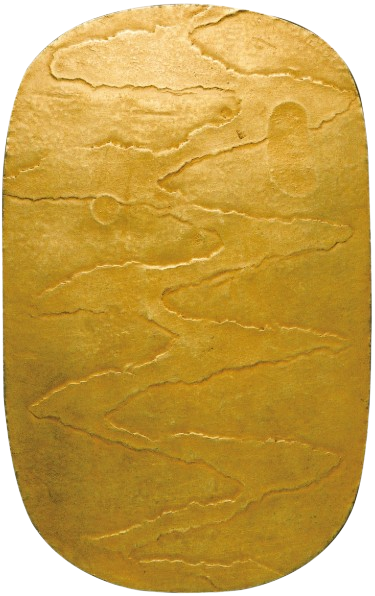Yuzuriha Ōban Kin (譲葉大判金)


(Ginza Coins Collection, Tokyo. Reproduction authorized. © All rights reserved.)
Documentary evidence concerning this particular coin is rather limited; nevertheless, the most widely accepted hypothesis places its origin around the year 1588, suggesting its role as a prototype for the initial issues of the Tenshō Ōban. The obverse of the coin features a series of fine grooves, attributable to a meticulous hammering technique, indicative of a high level of artisanal skill. In contrast, the reverse is characterized by the complete absence of engravings, resulting in a smooth and uniform finish. The name by which the coin is known derives from its morphological resemblance to the leaves of the Yuzuriha plant, a species native to East Asia. In both numismatic and historiographical contexts, it is sometimes also referred to by the term Mumei Ōban Kin (無銘大板金), which may be translated as “golden Ōban without inscriptions.”
| Coin Name | Yuzuriha Ōban Kin |
| Japanese Inscription | 譲葉大判金 |
| Historical Period | Sengoku Period (1467–1603 AD) |
| Year of Minting | 1588 d.c. |
| Chronological Reference | Unspecified |
| Minting Location | Unspecified |
| Issuing Authority | Not definitively established |
| Function | Effective coinage (used for both commercial transactions and symbolic purposes, associated with local authority) |
| Material | Gold |
| Shape | Elongated |
| Altezza | 15.5 – 15.8 cm |
| Larghezza | 9.6 – 9.8 cm |
| Weight | 159 – 166 g |
| Manufacturing Technique | Manually executed casting and striking performed on stone surfaces |
| Obverse Text and Symbols | None |
| Reverse Text and Symbols | None |
| Calligrapher / Artist: | Unspecified |
| Museum References | Currency Museum Bank of Japan ⅡAカマb 2/1 |
| Number of Known Specimens | Numerous known specimens (not precisely quantified) |
References and Bibliography
The Gold of Tokugawa, Alberto Rolfini 2025
瀧澤武雄, 貨幣 Takizawa Takeo, Kahei Nipponshi sho Hyakka 1999
